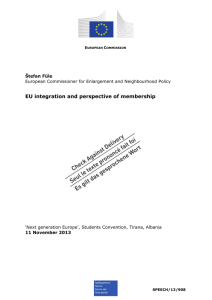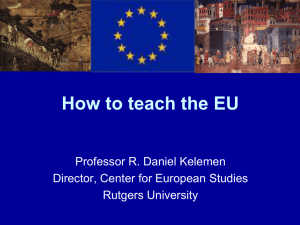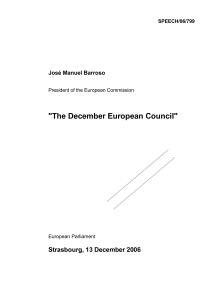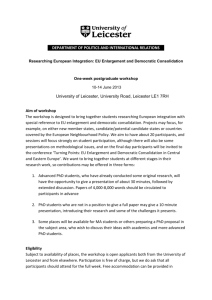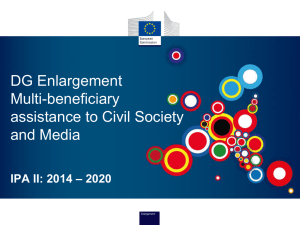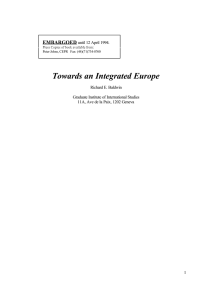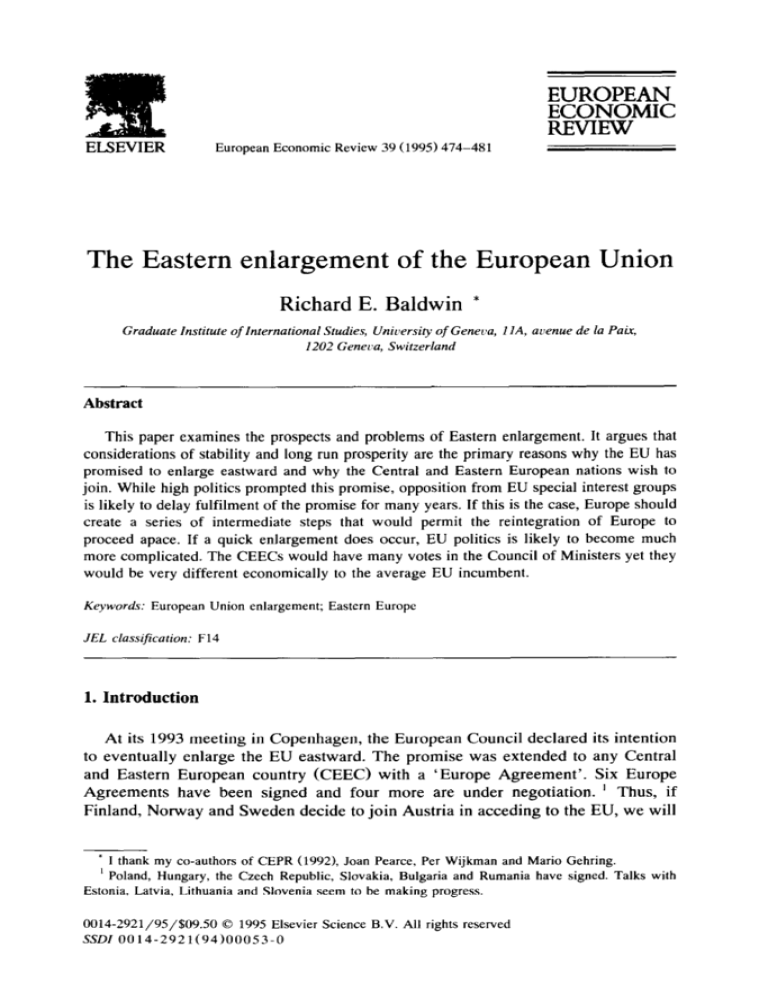
EUROPEAN
F6z%kmc
ELSEVIER
European Economic
Review 39 (1995) 474-481
The Eastern enlargement of the European Union
Richard E. Baldwin
Graduate Institute of International
*
Studies, Uniaersity of Geneva, I IA, avenue de la Paix,
1202 Genera. Switzerland
Abstract
This paper examines the prospects and problems of Eastern enlargement. It argues that
considerations of stability and long run prosperity are the primary reasons why the EU has
promised to enlarge eastward and why the Central and Eastern European nations wish to
join. While high politics prompted this promise, opposition from EU special interest groups
is likely to delay fulfilment of the promise for many years. If this is the case, Europe should
create a series of intermediate steps that would permit the reintegration of Europe to
proceed apace. If a quick enlargement does occur, EU politics is likely to become much
more complicated. The CEECs would have many votes in the Council of Ministers yet they
would be very different economically to the average EU incumbent.
Keywords: European
JEL classification:
Union enlargement;
Eastern Europe
F14
1. Introduction
At its 1993 meeting in Copenhagen, the European Council declared
to eventually enlarge the EU eastward. The promise was extended to
and Eastern European country (CEEC) with a ‘Europe Agreement’.
Agreements have been signed and four more are under negotiation.
Finland, Norway and Sweden decide to join Austria in acceding to the
its intention
any Central
Six Europe
’ Thus, if
EU, we will
* I thank my co-authors of CEPR (1992), Joan Pearce, Per Wijkman and Mario Gehring.
’ Poland, Hungary, the Czech Republic, Slovakia, Bulgaria and Rumania have signed. Talks with
Estonia, Latvia, Lithuania and Slovenia seem to be making progress.
0014-2921/95/$09,50
0 1995 Elsevier Science B.V. All rights reserved
SSDI 0014-2921(94)00053-O
R.E. Baldwin /European
Economic Review 39 (1995) 474-481
475
have the EU16. The Copenhagen declaration indicates that this could eventually
rise to the EU26.
The gains from enlarging the EU eastward are potentially enormous. Indeed, it
is easy to forget what is at stake. Until recently, millions of men and billions of
dollars of equipment stood poised for combat in Europe. Communism’s
demise
defused this situation by destroying the existing political and economic structures
in the East. However, the outcome of this ‘political creative destruction’ is still
uncertain. If all goes right, rapid Eastern growth would lock in democratic and
pro-market reforms, fostering peace and stability throughout the continent. In
particular, expanding the market to another 100 million consumers, would be a
bonanza for West European exporters. 2 However, if all goes wrong, widespread
economic failure in the East could have serious consequences for all of Europe.
Even if this did not provoke a return to authoritarianism,
serious political or
economic turmoil in the East could lead to mass migrations
and harm the
confidence of investors throughout Europe. An intermediate outcome is the most
likely, but these two extreme scenarios serve to illustrate an important fact. Europe
is at a turning point in its history. 3
The EU is a club in which every incumbent has a veto over every new member.
To understand an EU enlargement, one must therefore consider why the entrants
wish to join and why the incumbents wish to have them. Three types of concerns
influence the positions of both sides: economics,
‘low’ and ‘high’ politics.
Economics is taken to mean the standard aggregate welfare gain or loss, typically
expressed in percent of GDP. Low politics refers to the manner in which an
enlargement’s impact on certain special interest groups can take on an importance
that far exceeds the groups’ electoral or economic weight. High politics concerns,
for instance, the role of European integration in maintaining peace and democracy.
The timing and size of Eastern enlargement
is uncertain. Perhaps the most
common scenario is that the Visegrad
(Czech Republic, Hungary, Poland and
Slovakia) and perhaps Slovenia would be in the first enlargement,
with other
CEECs joining later. The most optimistic scenario for the first enlargement
assumes that talks begin after the 1996 Inter-Government
Conference with accession occurring at the turn of the century.
2. Why the EU wants to enlarge eastward
High politics is clearly the strongest force behind the EU’s decision to enlarge
eastward. While the path that each CEEC takes depends mainly on the daily
2
This population figure includes the Visegrad4, Slovenia, the Baltic States, Albania,
Rumania.
’ Jacques Attali expressed this more eloquently in his 3 December 1992 speech.
Bulgaria
and
476
R.E. Baldwin /European
Economic Review 39 (1995) 474-481
actions of its own government and citizens, the promise or denial of EU membership could influence long run expectations. Closing the door on Eastern enlargement would have dimmed the CEECs’ prospects of participating in the wealth and
security of a united Europe. This might have discouraged faith in the painful
reform process and made Western firms more hesitant to invest in the region. By
promising eventual membership and simultaneously
liberalizing trade, the EU is
playing a familiar role. After all, vague promises of an ever-closer union together
with rapid expansion of intra-regional
commerce fostered peace, prosperity and
understanding
among former West European combatants.
By taking steps to
integrate East and West Europe - starting with free trade and ending in Eastern
enlargement - the EU may replay this role in the post-Berlin Wall era.
The promise to eventually enlarge eastward was extended by a unanimous
decision, however there are important differences among the member states. It is
easy to understand that the spectre of Eastern economic and political turmoil looks
worse in Berlin than in Madrid. Moreover, the commercial gains from closer
integration also look more attractive to incumbents
that are historically and
geographically
the CEECs’ natural trading partners. These differences among
incumbent member states will amplify the difficulties of taking the final decision
to admit new Central and Eastern members. This is especially true since, as we
shall see below, these divisions line up roughly with concerns about the low
politics of enlargement.
Economics. The EU’s economic interest in an Eastern enlargement is probably
quite minor. I know of no systematic evaluations of the welfare effects of an
Eastern enlargement, however studies of NAFTA’s impact on Mexico and the US
(see Francois and Shiells, 1992) allow some tentative analysis-by-analogy.
When
an economically small region integrates with an economically large region, both
gain but the small region gains much more. Moreover, when a low-wage/lowproductivity region and a high-wage/ high-productivity
region integrate, most of
the large region’s gains come from cheaper imports of labour intense goods such
as clothes and shoes. This suggests that the aggregate economic gains to the EU
incumbents are likely to be small and may cause problems (see Neven, 1994;
Rollo and Smith, 19931 of a low politics nature.
Calculating the aggregate welfare effects of enlarging eastward is hard, but
calculating the trade effects is not. Using a gravity model, Baldwin (1994) projects
that the CEECs could in the long run account for 5%-10% of most incumbents’
exports; for Austria, Finland, Greece, Italy and Sweden the figure is over 20%. 4
This would imply double digit growth in EU exports to the CEECs for decades.
4 This assumes the CEECs’ incomes catch up to those of the poorer incumbents. The appendix tables
in Baldwin (1994) contain typographical
errors. The original gravity model is available on diskette
from the author.
R.E. Baldwin/European Economic Review 39 (1995) 474-481
477
2.1. The low politics of Eastern enlargement
While high politics prompted the promise of membership, low politics will
likely determine when the promise is fulfilled. Economic change is usually painful
for certain groups in the economy, the magnitude of the pain increasing with the
size and ‘differentness’
of the region to be integrated. On both counts, any
substantial Eastern enlargement is likely to be very difficult for certain groups in
the EU. The simple fact is that the CEEC economies are now very different to the
average EU economy. For instance, the 64 million Visegrad citizens are now 2.5
times more agricultural and only 30% as rich as the EU12 average. This makes
them more populous, poorer and more agricultural than the incumbent poor four
(Ireland, Greece, Portugal and Spain) put together.
To the extent that these painful readjustments
fall on politically powerful
groups in the EU, enlargement will be politically difficult. My book, Baldwin
(19941, discusses these difficulties at length (and provides references to other
studies). The main difficulties concern: budget and voting issues and the ‘big step’
factor.
Budget issues. Here I focus on the optimistic
scenario of a Visegrad enlargement
in 2000. The extra budget outlays of this can be roughly estimated by combining
the findings of two studies. A careful study by Anderson and Tyers (1993)
estimates that a Visegrad enlargement would raise the cost of the McSharry-reformed CAP by $47 billion annually. Courchene et al. (1993, p. 114) estimate that
it would cost ECU 26 billion to extend the Structural Funds to Visegraders under
current rules. Adding these up with a rough guess on Visegrad contributions
implies that admitting the Visegraders in 2000 would increase annual EU spending
by 58 billion ECU. This is 60% of the EU’s projected budget in 2000.
Financing this extra cost would require a drastic cut in EU spending and/or an
increase in incumbent contributions.
Raising taxes or deficits to cover this cost
would be unpopular with EU voters, especially since citizens in northern EU
nations would probably be asked to pay for most of it. The low politics of cutting
spending is even more difficult. Since EU farmers and poor regions currently
receive 80% of all EU spending, most of the spending cuts would inevitable fall
on these two extremely powerful interest groups.
The budget problems are likely to remain for decades. Under current rules, a
region is eligible for the biggest slice of EU structural spending as long as its
average income is less than 75% of the EU average. If the EU income average
grows at 2% and Visegraders’ averaged three times that pace, two decades would
pass before they reached the 75% cutoff. ’ If the Visegraders managed to grow
5
This takes 1991 data as a base year from which the twenty years is applied.
478
R.E. Baldwin /European
Economic Review 39 (1995) 474-481
‘only’ twice as fast as the EU, it would take three decades. Rising CEEC incomes
might never change the cost of extending the CAP. Visegrad countries are blessed
with fertile land (well suited to the products most heavily protected by the CAP)
and there is no reason Visegrad farmers could not be as productive as German
farmers in 20 years. Thus, any substantial Eastern enlargement
is likely to
bankrupt the CAP. Of course, further liberalization of the CAP is inevitable. But
the size and urgency of reform will be magnified by Eastern enlargement.
The low politics of all this is obvious, As a matter of self-defense, coalitions of
farmers and poor regions are likely to veto an Eastern enlargement until CEECs
get much richer and much less agricultural. This could take at least two decades.
Voting issues. Previous EU enlargements have sharply altered the EU’s political
landscape. Just think of how the Iberian enlargement modified the balance of
voting power between rich and poor members and shifted EU spending priorities
towards transfers to poor regions. Under current practices Visegraders would
receive more Council of Minister votes than Spain, Portugal, Ireland and Greece
put together. Surely this would transform EU politics. It is impossible, however, to
say exactly how. Fears of what might happen may lead special interest groups
currently receiving EU funding to push for a delay in Eastern enlargement.
A related issue is the reform of EU voting procedures foreseen for the 1996
Inter-Governmental
Conference. It is often asserted that EU decision making
should be streamlined. The need for streamlining, and therefore the extent of the
1996 reforms, critically depends on how soon and how far the EU plans to enlarge
eastward. Since a likely target of this streamlining is the disproportional representation of EU citizens living in small countries, small EU nations may face a
tradeoff in 1996 between preserving their power and supporting an early Eastern
enlargement.
All this suggests that powerful coalitions of incumbent farmers and poor
regions (and perhaps small countries) are likely to delay the Eastern enlargement
for a very long time. Of course, the future is full of surprises and extreme political
events could convince West European voters to open their pocket books and admit
some CEECs.
Enlargement on the cheap. One solution to early-enlargement
budget costs would
be to exclude entrants from structural spending until they were too rich to need it,
and from the CAP and food trade for however long incumbent EU farmers wanted.
This ‘solution’, however, is likely to cause enormous political complications.
Excluding entrants from 80% of EU spending, but giving them voting rights, could
be very disruptive to EU decision making. To put it colloquially, unpleasantness is
unavoidable, if second-class ticket holders can vote on what first-class passengers
will have for dinner. If the new members were also excluded from voting on most
issues, the result would be a second-class status for CEECs. This would be EU
membership in name only.
R.E. Baldwin/European Economic Review 39 (199.5)474-481
479
The big step problem. A more abstract problem concerns the ability of CEEC
governments and businesses to deal with all the obligations of EU membership.
Assuming the obligations of EU membership requires more than passing the right
sort of laws. It requires a great deal of human capital. Government departments in
West Europe are run by officials who have decades of experience in regulating a
market economy without stifling it. Western corporations have managers with
decades of experience in complying with government
regulations while still
making a profit. The CEECs have very few such people in government or the
private sector. Training programmes can help, but as we all know there is no
substitute for experience. Gaining the necessary on-the-job experience to run a
market-based economy at the level needed to meet EU obligations will take years,
if not decades.
Another way to look at the big step problem is to compare the optimistic
scenario of Visegrad enlargement in 2000 with how long it took EU incumbents to
arrive at their current level of integration. It is useful to distinguish four steps in
European integration: bilateral free trade agreements (FTAs) with the EU, the
Common Market, the Single Market and Economic and Monetary Union (EMU).
Plainly not all steps are relevant to each nation. Table 1 shows the number of years
the various EU entrants spent at each stage (including transitional periods). Notice
that it took the EFTA4 ‘only’ 20 years to achieve the Single-Market
level of
integration, while it took the original 6 members 28 years. Under the optimistic
scenario, the Visegraders would skip over this step entirely, jumping directly to
the EMU; All this, just 8 to 10 years after they signed bilateral FTAs the EU
Table 1
Years spent at each integration
step (including
transition
periods) a
Bilateral
FTA
Common market
1958-86
Single market
EMU
1993-99?
Total years
Austria, Sweden,
Finland, Norway
20
skip
2
4
26
Spain
16
skip
7
6
29
Portugal
13
skip
I
6
26
Greece
20
5
7
6
38
Ireland, Denmark,
Great Britain
skip
13
7
6
26
Original 6
skip
28
7
6
41
skip
skip
skip
CEECs (optimistic
scenario)
8-10
a Table assumes (1) EMU occurs in 1999 for all members;
stage for EFTM; and (3) EFTA4 all accede in 1995.
8-10
(2) the 1993 EEA was the Single Market
480
R.E. Baldwin /European
Economic Review 39 (1995) 474-481
(some were signed in 1991, others in 1993). Of course, the Visegrad nations are
already adopting Single Market legislation, but passing laws and having the human
capital to enforce them are quite different things.
The lessons of history are vague and there is no hard reason to think that the
number of years taken by previous EU entrants has any implications for how long
it will take the CEECs to get in. One point, however, is indisputable.
If the
Visegrad nations manage to take the very large step to membership within a
decade, they will be breaking all historical speed records. Of course the current
leaders of the CEECs are accustomed to breaking records. In a few short years
they saw their entire political and economic structures demolished. It might be
worth recalling, however, that it is much easier to set speed records in pulling
down old structures than it is in building new ones.
3. Why the CEECS want to join
As argued above, the economic gains from EU membership are likely to be
large for the CEECs. Note, however, that full membership is not necessary to
attain most of these economic benefits. The Europe Agreements promise to phase
out all regular EU trade barriers against CEEC industrial products. An EEA-like
arrangement that extended the Single Market eastward would permit the CEECs to
secure most of the economic benefits of membership. Such access would also
make the CEECs very attractive to foreign investors, just as membership did for
Spain in the mid-1980s. The only big economic gains that would require full
membership are exactly those that create the most political problems in the EU:
participation in the CAP and transfers to poor regions.
These economic benefits, however, are overshadowed by high politics. For the
Central European countries, EU membership would symbolically restore them to
their historical positions among the advanced industrial economies of continental
Europe. More importantly,
membership would have a decisive impact on the
domestic political scenes of all CEECs by firmly closing the book on authoritarianism - just as it did in Greece, Portugal and Spain. Membership would also lock
in existing pro-market reforms and facilitate further reforms. It is important to
note, however, that EU membership is neither necessary nor sufficient for such
reforms to occur. Finally, EU membership might be a critical factor in assuring
that any resurgence of authoritarianism
in the former USSR (should it occur)
would not lead to a ‘Finlandization’
of the CEECs.
4. Concluding
remarks
I have argued that Eastern enlargement is likely to be delayed for many years
due to pressure from special interest groups in incumbent nations. If this is the
R.E. Baldwin/European Economic Review 39 (1995) 474-481
481
case, then Europe should create a series of intermediate steps that would permit
the reintegration of East and West Europe to proceed apace. 6 If a quick
enlargement does occur, EU politics is likely to become very much more
complicated.
References
Anderson, K. and R. Tyers, 1993, implications of EC expansion for European agricultural policies,
trade and welfare, Discussion paper no. 829 (CEPR, London).
Attali, J., 1992, A global European initiative, Speech to European Policy Forum, London.
Baldwin, R., 1994, Towards an integrated Europe (CEPR, London).
CEPR, 1992, Is bigger better? The economics of EC enlargement, Monitoring European Integration 3
(CEPR, London).
Courchene, T. et al., 1993, Stable money - sound finances, European Economy, No. 53.
Francois, J. and C. Shiells, eds., 1994, Modeling trade policy: Applied general equilibrium assessments
of North American free trade (Cambridge University Press, Cambridge).
Rollo, J.M. and M.A.M. Smith, 1993, The political economy of central European trade with the
European Community: Why so sensitive?, Economic Policy 16.
Neven, D., 1994, Trade liberalization with Eastern nations: How sensitive?, Working paper (University
of Lausanne, Lausannel July.
’ Baldwin (1994) considers
several intermediate
steps,

